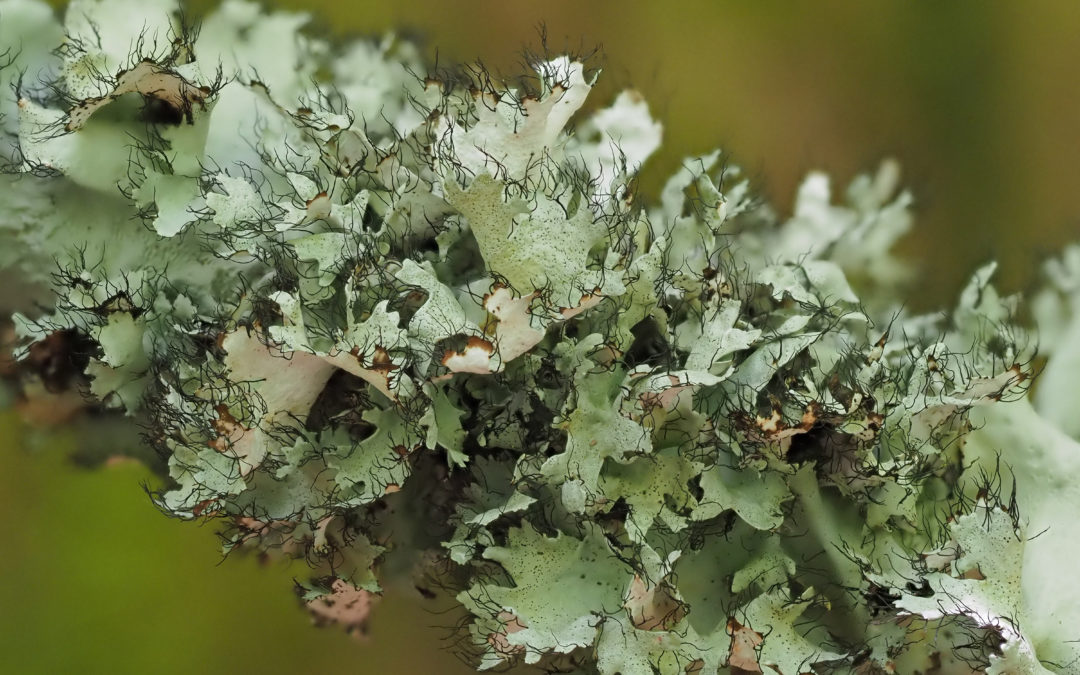After the first meeting, if the fungus and algae are compatible, they can make a lichen body (thallus). This means that only certain algae and certain fungi can get together to form a lichen.
Lichens are a symbiotic partnership of two or more separate lifeforms, a fungus and an algae and/or cyanobacterium. Each unique combination of algae and fungus species brings forth a new lichen combination, and thus, a new lichen species. There are roughly 3,600 known species of lichens in North America, and new discoveries are being made every year.
The dominant partner in a lichen relationship is the fungus, or “mycobiont”, which gives the lichen most of its physical characteristics, from its thallus shape to its fruiting bodies. It also gives the lichen structure and stability. Fungi have existed for hundreds of millions of years, in many shapes and forms, and are masters of symbiosis. Countless fungi species have symbiotic relationships in forests, forming nutrient networks with trees via mycorrhizae, and with orchids and other special plants that don’t obtain nutrients through photosynthesis. Fungi are negotiators of the first degree, true relationship experts!
The photosynthetic partner of a lichen is either a green algae or a cyanobacterium, but about 15% of Pacific Northwest lichen species contain one or more of each. The photosynthetic partner, or “photobiont”, produces sugars through photosynthesis, which feed all partners in the lichen organism. In addition, any cyanobacteria partners are able to collect nitrogen from the air and “fix” it in nodules on the lichen surface. This process makes nitrogen available to the lichen itself, as well as other plants in the environment. You can usually tell what kind of algae a lichen contains by its color alone. When a lichen is dry, its color is usually gray or colored like the fungal cells on the upper layer. But when a lichen is wet, those cells become transparent, and the algae cells underneath get a chance to show their vibrancy.
Algae have also existed since before the evolution of land plants, and different species are adapted to different situations. They utilize different pigments for photosynthesis, so they come in different colors: brown, red, and gold, as well as green. Most algae partners in lichen are green algae, and exist in layers with the fungal partners, like a sandwich. Many lichens look green because of the green algae, but some lichens are orange or yellow due to the fungal partner showing its colors as well. Cyanobacteria can be a layer under the upper fungal layer, or cortex, or in tiny pockets on top of the upper cortex if there is a green algae layer already present. Cyanobacteria will give the lichen a dark green, brown, or black color.
There are three main types of lichens, described by their shapes: Foliose lichens are flat, and have an identifiable top and bottom side. They can be flat and leafy like lettuce, or rippled and bumpy. Fruticose lichens can be seen hanging from trees and look like hair, or they can be bushy and sitting upright. They have round branches that look like tubes or flat, thin branches that tangle together. Crustose lichens are flat and thin, and form a crust over their substrate. They come in many colors, including orange or yellow, as well as gray or green, and grow pressed tightly to their substrate.
Lichens are found throughout North America and all over the world, from the Sonoran desert to the alpine tundra of Alaskan mountains, and in tropical rainforests. And there are many species right here at SHADOW. The first lichens are believed to have evolved about 250 million years ago, when earth was a very harsh environment. That’s about 100 million years later than the ferns and first true land plants. Lichens are also an important part of the crytobiotic soil crusts found in extreme ecosystems like deserts. When lichens establish themselves on rock, they secrete acids that help break down the rock into particles, which can become soil for the growth of plants. They are ecosystem builders that provide a mode of survival in harsh environments where algae cannot normally survive; some say that algae converts more carbon dioxide to oxygen than plants do! Lichens are important indicators of air quality, because they absorb everything in their atmosphere, including toxins. The more lichen you have around you, the better the air and water quality.
“Lichens are important in many ways in the habitat. Some make the nitrogen in the air usable to plants, They are homes for spiders, mites, lice, and other insects. All are important in the nutrient cycle in the places where they grow. Lichens have been used for many things by both animals and humans. They provide forage, shelter, and building materials for elk, deer, birds, and insects.” – US Forest Service
https://www.fs.usda.gov/wildflowers/beauty/lichens
http://gis.nacse.org/lichenland/
By SHADOW Intern, Shelley Pasco


Recent Comments